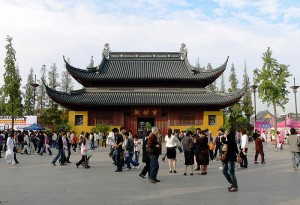Buddha, Meditation, Medicine
Monks lead march to save Himalayas
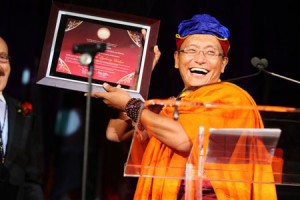
The Drukpa Kargyu school (Dzongkha: or simply Drukpa school, is a branch of the Kagyu school of Tibetan Buddhism. It is considered to be one of the Sarma or „new“ schools of Tibetan Buddhism. Within the Drukpa Lineage, there are further sub-schools, most notably the eastern Kham tradition and middle Drukpa school which prospered in Ladakh and surrounding areas. In Bhutan the Drukpa Lineage is the dominant school and state religion. Read More: > HERE <
www.live2love.org On 19th September 2010, His Holiness the Gyalwang Drukpa, founder of Live To Love, a new world-wide charity specializing in building the world’s most advanced eco-friendly schools and teaching young women leadership skills, received the United Nations‘ Millennium Development Goal (MDG) Award for those efforts.At a star-studded event headlined by American actress Christie Brinkley, Ghanian-American hip-hop artist, Blitz the Ambassador American saxophonist, Dave Koz and joined by heads of state and leading dignitaries gathered to honor governments and individuals making substantial contributions toward fulfilling the UN’s Millennium Development Goals, His Holiness the Gyalwang Drukpa was feted for Live To Love’s efforts to “create compassion into action.”The annual MDG Awards provide a platform to raise awareness about the critical work of the United Nations and honor and celebrate the exceptional work of select national governments and individuals contributing to the achievement of the MDGs around the world.
Guru Rinpoche highlighted many times in his teachings and biography that so long as the descendents of the famous and great Tibetan King Trisong Deutsan is there, his blessing will always be there. As we all know Trisong Deutsan is the direct emanation of Manjushri, the Bodhisattva of Great Wisdom. These days, our beloved king of Ladakh, Trinlay Namgyal, has not been well, and he is definitely a genuine descendent of Trisong Deutsan. This is the reason why I went to Ladakh for a day trip and stayed there only for an hour.
Out of respect and care, I went to Ladakh to visit the king who has been my good friend for a very long time. I had never been to Ladakh for such a short trip. Even if I wanted to stay, I had no choice, there is already the Sikkim Eco Pad Yatra program starting soon. I am very happy that I saw him, I hope he was happy to see him. He was very seriously sick inside, but he has no pain. I am writing not only because he is a dear friend of mine, but I believe in Guru Rinpoche’s words and I know for sure that the king definitely carries the blood of Trisong Deutsan and therefore the blessing of Guru Rinpoche.
A short video showing the walking pilgrimage journey from Lahaul to Ladakh (from 23rd May to 1st July 2009) undertaken by His Holiness the Gyalwang Drukpa, His Eminence Kyabje Khamtrul Rinpoche, several Rinpoches, monks and nuns and lay followers – about 750 humans and 320 mules. /Join His Holiness the Gyalwang Drukpa and 750 nuns, monks, & friends of the Drukpa Lineage as they trek 400 kilometers across the Himalayas in a grassroots movement to elevate environmental awareness, promote education for women, and celebrate the heritage of a culture in peril. www.walking.drukpa.com OPTION C (22nd-28th December 2010) & OPTION D (24th-28th December 2010) ARE NOW AVAILABLE.
Now, I am on the way preparing for the Sikkim Eco Pad Yatra and catching up with my busy schedule. Let’s see how it will go. It seems that it’s being arranged quite well, due to help from my friends and students, especially Drukpa Publications whom I asked to arrange this through my own office. Just as our last pad yatra in Ladakh last year, this time also I took the opportunity to ask Rigzin Namgyal to arrange this for us. I know that Rigzin Namgyal along with Lotus’s help is trying his best to make all of us very comfortable and successful. Maybe next time I should be fair enough not to demand him that badly in making these difficult arrangements, such as in locations unfamiliar for him, but this time I have to apologise that I did that.
For the forthcoming Sikkim Eco Pad Yatra, I have 2 very special guests who will be joining with us, that is Gyalwa Lorepa and Drukpa Yongdzin Rinpoche. I am sure that all of you will see all the updates at the Drukpa Facebook or from different channels. I will leave you here until I return from the Pad Yatra. Take care and let’s move on and get ready for the Pad Yatra and a new year.
- http://www.khoryug.com
- http://ladakh.drukpa.com/monasteries.htm
- http://economictimes.indiatimes.com/environment/
- Article on UN Millenium Goals
- Meet Drukpa Order, studies, friends, fans at fb
- Meet Mind & Life Institute, studies, friends, fans at fb
- Meet Ecotourism, studies, friends, fans at fb
- Meet Ecobuddhism, studies, friends, fans at fb
Traditional Food, Medicine & Biodiversity
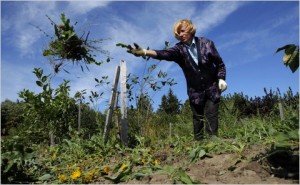
The N.I. Vavilov Institute of Plant Industry
Nikolai Ivanovich Vavilov (Russian: Николай Иванович Вавилов) was a prominent Russian and Soviet botanist and geneticist best known for having identified the centres of origin of cultivated plants. He devoted his life to the study and improvement of wheat, corn, and other cereal crops that sustain the global population. While developing his theory on the centres of origin of cultivated plants, Vavilov organized a series of botanical-agronomic expeditions, collected seeds from every corner of the globe, and created in Leningrad the world’s largest collection of plant seeds. Read More: > HERE <
The Convention on Biological Diversity (CBD), known informally as the Biodiversity Convention, is an international legally binding treaty. The Convention has three main goals: 1. conservation of biological diversity (or biodiversity);2. sustainable use of its components; and 3. fair and equitable sharing of benefits arising from genetic resources. In other words, its objective is to develop national strategies for the conservation and sustainable use of biological diversity. It is often seen as the key document regarding sustainable development. Read More: >HERE<
Ensuring that the genetic diversity of the world’s food crops is preserved for future generations is an important contribution toward the reduction of hunger and poverty in developing countries. This is where the greatest plant diversity originates and where the need for food security and the further development of agriculture is most urgent.
About VIR: “The scientific network of VIR includes the institute’s headquarters with 9 plant resources departments, 13 fundamental research laboratories, and 12 experiment stations in different geographic zones of Russia. Its chief activities are Plant Genetics Resources (PGR) collections, conservation and study.”
This recent news item was originally reported on Science Magazine’s Science Insider news feed. Earlier reportage on this story came from The Scientist blog. Top Photo: Alaska wild “berries” from the Innoko National Wildlife Refuge; U.S. Fish and Wildlife Service employee (public domain). Bottom Photo: VIR, Pavlosk Exp. Station http://www.greendump.net
Last week, we described the plight of the Russian Pavlovsk Experimental Station: Plans for a housing complex threaten some 5,000 rare plants, including varieties found nowhere else on the planet. A court judgment last week meant that only the president or prime minister could save the plants, which scientists said would take years to relocate. Now government telegrams and a presidential tweet hint that the plants might have a chance. http://blogs.discovermagazine.com
Russia Defers Razing of Seed Repository – modest reprieve for a seed bank that is home to the world’s largest collection of European fruits and berries. http://green.blogs.nytimes.com
The Vavilov Institute in Russia is the oldest seed bank in the world with a collection of over 325,000 samples of seed. Video from The Vavilov Institute from The Seed Hunter on National Geographic Channel http://natgeotv.com
Vavilov Institut Alblinse, Russian Housing Plan Threatens Seed Bank
The Institute of Plant Industry http://www.vir.nw.ru/ was established in 1921. Nikolai Vavilov was the head of this institute from 1924 to 1936 and had, and still has, the world’s largest collection of plant seeds. During the early 1930s, he became the target of the Lysenkoist debate and was exiled. In 2010 the plant collection at the Pavlovsk Experimental Station was to be destroyed to make way for luxury housing
IRRI http://irri.org Rice Research is a nonprofit research and education center established to reduce poverty and hunger, improve the health of rice farmers and consumers, and ensure environmental sustainability
Navdanya http://www.navdanya.org is a network of seed keepers and organic producers spread across 16 states in India.Navdanya has helped set up 54 community seed banks across the country, trained over 500,000 farmers in seed sovereignty, food sovereignty and sustainable agriculture over the past two decades, and helped setup the largest direct marketing, fair trade organic network in the country.
ARCHE NOAH: http://www.arche-noah.at Wir sehen unsere Arbeit als Antwort auf die restriktive globale Saatgutpolitik. Die Vielfalt an Kulturpflanzen ist Lebensgrundlage für kommenden Generationen. Und Lebensqualität für uns alle ! Wir sind ein Verein, der sich seit fast 20 Jahren für den Erhalt alter Kulturpflanzen einsetzt, mit über 8.000 Mitgliedern, Förderern und aktiven ErhalterInnen.
Svalbard Global Seed Vault – Cultural plants for the future. http://www.regjeringen.no Since the climate conditions change so rapidly, it is extremely important to ensure the genetic diversity of all the cultural plants of the world. In these genes, we will find the necessary qualities to make effective cultural plants in the future. This is absolutely necessary to secure a satisfactory food supply for the global population. Within the next 40 years, the world’s food production must be doubled, says the Norwegian minister of agriculture and food, Lars Peder Brekk.
Was wären die Schwaben ohne ihre Linsen? Trotzdem stellten Ende der 50er Jahre die letzten Landwirte “auf der Alb” den Anbau von Linsen ein, da die Importe zu billig waren und den Verbrauchern egal war, woher ihre Linsen kamen. Im Pflanzenbau herrschte damals der Zeitgeist “höher, schneller und immer mehr”. Hauptsache, der Ertrag von Weizen, Mais und Kartoffeln stieg. Egal, wie viel “Chemie” dazu auf den Acker kam. Diese Ideologie war den hiesigen Bio-Bauern schon immer ein Dorn im Auge.
Außerdem vermissten sie ihre Heimatfrucht aus der Kindheit: “Die alten Bauern bei uns in der Gegend haben uns erzählt, wie sie noch Linsen angebaut haben, zusammen mit Gerste ( GERSTE IM AYURVEDA ) und Hafer, als Stützfrucht für die zarten Pflanzen. Beim Linsen essen haben wir davon geträumt, wieder Alb-Linsen auszusäen”, erinnert sich Woldemar Mammel. Der Bioland-Bauer aus Lauterach auf der Alb baut bereits seit den 80er Jahren wieder Linsen an und begeisterte auch andere für seine Idee. Mittlerweile machen elf Bäuerinnen und Bauern in der “Öko-Erzeugergemeinschaft «Alb-Leisa»” mit und bewirtschaften 30 Hektar mit Albleisen.
Unterstützung bekommen sie von anderen Verfechtern guter Esskultur: Vor zwei Jahren hat Slow Food Deutschland die Alb-Linse in die “Arche des Geschmacks” aufgenommen, um dieses traditionelle landwirtschaftliche Erzeugnis der Schwäbischen Alb vor dem Vergessen zu retten. Die Sache hat nur einen Haken: Die original schwäbischen Alb-Linsen waren bis vor kurzem unauffindbar und so mussten sich die Bio-Bauern mit französischen und italienischen Sorten behelfen. “Niemand hatte es für nötig gehalten, diese einzigartigen, im Bundessortenregister eingetragenen Linsensorten aufzubewahren”, beklagt Mammel.
Doch die verschollenen Linsen berührten auch andere schwäbische Herzen: 2006 machten sich unabhängig voneinander der private Pflanzenzüchter Klaus Lang und Klaus Amler von der Stuttgarter Agentur Ökonsult auf die Suche. Beide werden ein Jahr später in Russland fündig! Das Wawilow-Institut in St. Petersburg, das seit 1925 für die Genvielfalt der Nutzpflanzen kämpft, hat die zwei Sorten aufbewahrt.
RICE: Rice is first mentioned in the Yajur Veda (c. 1500-800 BC) and then is frequently referred to in Sanskrit texts. Today, the majority of all rice produced comes from India, China, Japan, Indonesia, Thailand, Burma, and Bangladesh.
Asian farmers still account for 92-percent of the world’s total rice production. Rice is grown in all parts of India. Genetics shows that rice was first domesticated in the region of the Yangtze River Valley. Read More: > HERE <
- www.pranapositive.com/shm/Save Herbal Medicine
- Articles on Biodiversity
- IRRI Rice Research/Climate Change /Bioversity/Eco Crises
- www.intlcss.org International Crop Science Society
- ARCHE NOAH, Erhaltung/Verbreitung Kulturpflanzenvielfalt
- Meet UN International Day 2010 of Biodiversity at fb
- Meet Global Biodiversity Protection at fb
- www.ienearth.org Indigenous Environmental Network at fb
- www.navdanya.org studies friends fans at fb
- www.ecobuddhism, friends and studies at fb
- Greenpeace China 绿色和平 綠色和平 at fb
- Meet SLOW FOOD , friends, pages at fb
- Meet TIBETAN TSAMPA Group and Friends at fb
- http://en.wikipedia.org/wiki/Farmers’_suicides_in_India
- http://en.wikipedia.org/wiki/Europ.Directive Trad.Herbal_Med.Products
- Meet COP 16 UN Conference, friends, studies, fans at fb
- Meet International Year of Biodiversity, friends, fans at fb
- Meet NaturalNews.com at facebook
NaturalNews.com is an independent news resource that covers the natural health and wellness topics that empower individuals to make positive changes in their personal health. NaturalNews offers uncensored news that allows for healthier choice.
3rd Annual Atlanta Tibetan Festival
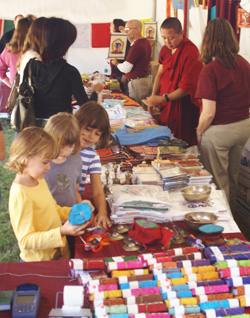
Drepung Monastery (wylie: ‚bras spungs dgon),(literally “Rice Heap” monastery), located at the foot of Mount Gephel, is one of the „great three“ Gelukpa university monasteries of Tibet. The other two are Ganden and Sera. Drepung is the largest of all Tibetan monasteries and is located on the Gambo Utse mountain, 5 kilometers from the western suburb of Lhasa. Freddie Spencer Chapman reported, after his 1936-37 trip to Tibet, that Drepung was at that time the largest monastery in the world, and housed 7,700 monks, „but sometimes as many as 10,000 monks.“ Read More: > Here <
The Gelug or Gelug-pa (or dGe Lugs Pa, dge-lugs-pa, or Dgelugspa), also known as the Yellow Hat sect, is a school of Buddhism founded by Tsongkhapa (1357–1419), a philosopher and Tibetan religious leader. The first monastery he established was at Ganden, and to this day the Ganden Tripa is the nominal head of the school, though its most influential figure is the Dalai Lama. Read more: > HERE <
Emory University is a private research university located in the metropolitan Atlanta area of Druid Hills, Georgia. The university was founded as Emory College in 1836 in Oxford, Georgia by a small group of Methodists and was named in honor of John Emory, a well-known Methodist bishop. Read More: > HERE <
Since His Holiness the Dalai Lama blessed our center in 2007, Drepung Loseling has been working towards completing its vision of creating a “Little Tibet” in Atlanta. Last year’s Tibetan Festival was voted by the Atlanta Journal Constitution as “The Top Thing to do”. Hundreds of visitors have enjoyed the last two festivals and we promise this year’s program will be just as fun.
Bring your family and friends to this special celebration of Tibetan culture. Activities include meditation, Tibetan food, music, dance, games, a Tibetan Bazaar, children’s arts and crafts, door prizes, a raffle and a live performance and workshop presented by the monks of the Mystical Arts of Tibet.
3rd Annual Atlanta Tibetan Festival
Saturday, November 6, 2010 – 10 am to 4 pm
Come and join us for our annual Tibetan Festival. There will be Tibetan food, music and dance, a Tibetan market along with guided meditation and games for the children.
The Mission of Drepung Loseling – Following the legacy of Drepung Loseling Monastery, India, and with the patronage of His Holiness the Dalai Lama, Drepung Loseling is dedicated to the study and preservation of the Tibetan Buddhist tradition of wisdom and compassion. A center for the cultivation of both heart and intellect, it provides a sanctuary for the nurturance of inner peace and kindness, community understanding, and global healing.
In implementing this vision, Drepung Loseling has two main objectives: To contribute to North American culture by providing theoretical knowledge and practical training in Tibetan Buddhist scholarly traditions for Western students, scholars and the general public; and To help preserve the endangered Tibetan culture, which today leads a fragile existence in the exiled refugee communities in India and Nepal.
Sponsor A Monk – The Drepung Loseling Educational Fund was established in 1988 to preserve traditional Tibetan culture by sponsoring a monk in training at Drepung Loseling.
Over half of our population is comprised of recent refugees whose parents remain in Chinese occupied Tibet; therefore, they cannot provide them with support. We also have a number of young monks who are orphans.
The Drepung Loseling Educational Fund was established in 1988 to preserve traditional Tibetan culture by sponsoring a monk in training at Drepung Loseling. Conditions in the Tibetan refugee camps in India are basic, and the average family is poor.
Young monks born in India have little parental support, and depend almost entirely upon the production of our small farm. Over half of our population is comprised of recent refugees whose parents remain in Chinese occupied Tibet; therefore, they cannot provide them with support. We also have a number of young monks who are orphans.
The Monastery accepts all sincere candidates regardless of their financial situation and must support them by means of the proceeds of the same small parcel of land provided to the original 216 Loseling refugee monks. The Fund helps provide for the basic needs of food, health care and education for these monks.
His Holiness formally accepts professorship: His Holiness the XIV Dalai Lama serves as Presidential Distinguished Professor, the first university appointment accepted by the 1989 Nobel Peace Laureate and leader of the Tibetan people. This appointment gives students unique access to His Holiness, his teachings and his insights. The Emory-Tibet Partnership raises awareness of Emory University as a leading center of study of Tibetan philosophy and religion in the West with both Western-trained and traditionally trained scholars.
The Affiliation with Emory University – The May 1998 visit of His Holiness the Dalai Lama marked the historic culmination of three years of dialogue and planning. While visiting Emory University in 1995, he was approached by a faculty delegation to discuss the prospects of an affiliation between Drepung Loseling Monastery and Emory University. In response to his positive interest, the affiliation process was initiated. During these discussions it was decided that the best infrastructure for this arrangement would be a direct affiliation of Emory University with Drepung Loseling Monastery in India, as well as with Drepung Loseling, Drepung’s North American seat. This would allow Drepung Loseling to design various programs both in North America and in India for academic accreditation through Emory. With this precedent-setting partnership, Drepung Loseling provides a unique link between the resources and faculty of a major American university and principal scholastic Tibetan monastery-in-exile in India.
Upaya Zen Center – Joan Halifax Roshi
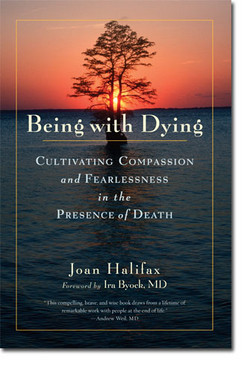
Roshi’s new book, Being with Dying
Joan Jiko Halifax (born 1942) is a Zen Buddhist roshi, anthropologist, ecologist, civil rights activist, hospice caregiver, and the author of several books on Buddhism and spirituality. She currently serves as abbot and guiding teacher of Upaya Zen Center in Santa Fe, New Mexico, a Zen Peacemaker community which she founded in 1990. Halifax-roshi has received Dharma transmission from both Bernard Glassman and Thich Nhat Hanh, and previously studied under the Korean master Seung Sahn. She is founder of the Ojai Foundation in California, which she led from 1979 to 1989. As a socially engaged Buddhist, Halifax has done extensive work with the dying through her Project on Being with Dying (which she founded). She is on the board of directors of the Mind and Life Institute, a non-profit organization dedicated in exploring the relationship of science and Buddhism. Read More: > HERE <
Zen is a school of MahÄ�yÄ�na Buddhism. The Japanese word Zen is derived from the Chinese word Chán, which in turn is derived from the Sanskrit word dhyÄ�na, which means „meditation“ or „meditative state.“ Zen emphasizes experiential prajñÄ� in the attainment of enlightenment. As such, it de-emphasizes theoretical knowledge in favor of direct realization through meditation and dharma practice. The teachings of Zen include various sources of MahÄ�yÄ�na thought, including the PrajñÄ�pÄ�ramitÄ� literature and the teachings of the YogÄ�cÄ�ra and TathÄ�gatagarbha schools. The emergence of Zen as a distinct school of Buddhism was first documented in China in the 7th century CE. From China, Zen spread south to Vietnam, and east to Korea and Japan. As a matter of tradition, the establishment of Zen is credited to the South Indian prince-turned-monk Bodhidharma, who came to China to teach a „special transmission outside scriptures, not founded on words or letters“. Read More: > HERE <
Meditation, Zen Buddhist Retreats, Chaplaincy Training and End-of-Life Care – Upaya Zen Center is a residential Buddhist community located in beautiful Santa Fe, NM. As a Zen center, we offer daily meditation which is open to the public, a weekly public Dharma talk which often highlights Buddhist teachings, a residential Path of Service and work exchange program, and weekly retreats and workshops focusing on practices related to engaged Buddhism, how to live in our world responsibly, with affection, kindness and wisdom. For your convenience, here is a downloadable document representing a synopsis of Learning and Buddhist Practice at Upaya.
Upaya Zen Center also offers a two-year Certificated Buddhist Chaplaincy Training Program in the areas of Prison, End of Life Care, Peacemaking, Women’s, Youth and Environmental Ministries and a Professional Training Program in Contemplative End of Life Care.
Upaya Zen Center is a Zen Buddhist practice, service, and training center. Our vision focuses on the integration of practice and social action, bringing together wisdom and compassion.
Our mission is to provide a context for community practice, education in Buddhism and social service in the areas of death and dying, prison work, the environment, women’s rights, and peacework. It endeavors to fulfill the vision of the Five Buddha Family Mandala, by understanding the integration of all of its functions.
The Five Buddha Family Mandala is based on the Five Meditation Buddhas of traditional Buddhism from India. It is a vision of Buddhism that is integrated, interconnected, and process oriented and is based on the integration of our spirituality, education, livelihood, service, and community into a whole cloth.
Joan Halifax Roshi is a Buddhist teacher, Zen priest, anthropologist, and author. She is Founder, Abbot, and Head Teacher of Upaya Zen Center, a Buddhist monastery in Santa Fe, New Mexico.
She has worked in the area of death and dying for over thirty years and is Director of the Project on Being with Dying. For the past twenty-five years, she has been active in environmental work.
A Founding Teacher of the Zen Peacemaker Order, her work and practice for more than three decades has focused on engaged Buddhism. Of recent, Roshi Joan Halifax is a distinguished invited scholar to the Library of Congress and the only woman and buddhist to be on the Advisory Council for the Tony Blair Foundation.
She is Founder and Director of the Upaya Prison Pro ject that develops programs on meditation for prisoners. She is founder of the Ojai Foundation, was an Honorary Research Fellow at Harvard University, and has taught in many universities, monasteries, and medical centers around the world.
She studied for a decade with Zen Teacher Seung Sahn and was a teacher in the Kwan Um Zen School. She received the Lamp Transmission from Thich Nhat Hanh, and was given Inka by Roshi Bernie Glassman. A Founding Teacher of the Zen Peacemaker Order, her work and practice for more than three decades has focused on engaged Buddhism.
UYGHUR – Trad. Medicine, Arts & Culture
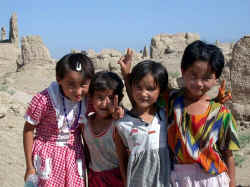
www.unpo.org/Uyghuren Nederland (VUN)
http://turkmenfriendship.blogspot.com
The Uyghur (Uyghur: ئۇيغۇر, Uyghur?; simplified Chinese: 维吾尔; traditional Chinese: 維吾爾; pinyin: Wéiwú’Ä�r; are a Turkic ethnic group living in Eastern and Central Asia. Today Uyghurs live primarily in the Xinjiang Uyghur Autonomous Region in the People’s Republic of China. An estimated 80 % of Xinjiang’s Uyghurs live in the southwestern portion of the region, the Tarim Basin. Large diasporic communities of Uyghurs exist in the Central Asian countries of Kazakhstan, Kyrgyzstan, and Uzbekistan. Smaller communities are found in Mongolia, Pakistan, Afghanistan, Turkey, Russia and Taoyuan County of Hunan province in south-central Mainland China. Uyghur neighborhoods can be found in major cities like Beijing, Shanghai, Sydney, Washington D.C, Munich, Tokyo, Toronto, Istanbul. Read More: > HERE <
Erkin Alptekin (born on July 4, 1939 in East Turkistan) is a noted international advocate for the rights of native and indigenous people. Among the organizations he has led are the Unrepresented Nations and Peoples Organization, of which he was formerly the chairman, and the World Uyghur Congress, of which he was the first president. Read More: > HERE <
Erkin Alptekin is one of the foremost human rights advocates for the Uighur people of Eastern Turkestan, also known as the Xinjiang Autonomous Region of the People’s Republic of China. Mr. Alptekin was employed by Radio Free Europe/Radio Liberty from 1971 to 1994. He is one of the founders of the Unrepresented Nations and People’s Organization (UNPO), and currently serves as its General Secretary. www.dalailamafoundation.org
Uyghur Medicine – The Uyghurs had an extensive knowledge of medicine and medical practice. Sung (Song) Dynasty (906-960) sources indicate that an Uyghur physician, Nanto, traveled to China, and brought with him many kinds of medicine not known to the Chinese.
There are 103 different herbs for use in Uyghur medicine recorded in a medical compendium completed by Li Shizen (1518-1593), a chinese medical authority. The Tartar scholar Rashit Rahmeti Arat has written two valuable books in German entitled Zur Heilkunde der Uighuren (Medical Practices of the Uygurs) , in 1930 and 1932, relying on Uyghur documents discovered in East Turkestan. In his book, Arat gives important information on Uyghur medicine and medical treatment.
Among other documents he studied he found a very important sketch of a man with an explanation of acupuncture. Relying on this document, some western scholars claim that acupuncture was not a Chinese, but a Central Asian invention and the Uyghurs perfected the method. Traditional Uyghur medicine, which can be traced back for more than 2,700 years through written records, is still very popular in East Turkestan today.
Tibetan Buddhist Medicine/Ancient Uyghur Civilization
Medicine – Tatar scholar, professor Reşit Rahmeti Arat in Zur Heilkunde der Uighuren (Medical Practices of the Uyghurs) published in 1930 and 1932, in Berlin, discussed Uyghur medicine. Relying on a sketch of a man with an explanation of acupuncture, he and some Western scholars suspect that acupuncture was not a Chinese, but an Uyghur discovery. Today, traditional Uyghur medicine can still be found at street stands. Similar to other traditional medicine, diagnosis is usually made through checking the pulse, symptoms, and disease history, and then the pharmacist pounds up different dried herbs, making personalized medicines according to the prescription. Modern Uyghur medical hospitals adopted the Western medical science and medicine and adopted Western pharmaceutical technology to discover new and produce traditional medicines.
- www.unpo.org , UNESCO – World Heritage
- Articles on Traditional Chinese Medicine <
- Articles on Traditional Tibetan Medicine <
- Gesellschaft für bedrohte Völker (GfbV), friends at fb <
- Meet STOP China’s GENOCIDE on the Uighur people, friends at fb <
- Meet EAST TURKESTAN UYGHURESTAN, friends, fans at fb <
- Meet Human Rights Watch, friends, fans at fb <
- Council for a Parliament of the World’s Religions (CPWR) at fb <
- The International Ecotourism Society (TIES)at fb <
TAOISM – Taoist Tai Chi Society™
Taoism (or Daoism) refers to a variety of related philosophical and religious traditions that have influenced Eastern Asia for more than two millennia, and have had a notable influence on the western world particularly since the 19th century. The word 道, Tao (or Dao, depending on the romanization scheme), literally translates as, „path“ or „way“ (of life), although in Chinese folk religion and philosophy it carries more abstract meanings. Taoist propriety and ethics emphasize the Three Jewels of the Tao: compassion, moderation, and humility, while Taoist thought generally focuses on nature, the relationship between humanity and the cosmos (天ä��相应), health and longevity, and wu wei (action through inaction), which is thought to produce harmony with the Universe. Read More: > HERE <
Tao (pronounced „Dow“) can be roughly translated into English as path, or the way. It is basically indefinable. It has to be experienced. It „refers to a power which envelops, surrounds and flows through all things, living and non-living. The Tao regulates natural processes and nourishes balance in the Universe. It embodies the harmony of opposites (i.e. there would be no love without hate, no light without dark, no male without female.)“
The founder of Taoism is believed by many religious historians to be Lao-Tse (604-531 BCE), whose life overlapped that of Confucius (551-479 BCE). (Alternative spellings: Lao Tze, Lao Tsu, Lao Tzu, Laozi, Laotze, etc.). However other historians suggest that he is a synthesis of a number of historical figures. Others suggest that he was a mythical figure. Still others suggest that he lived in the 4th century BCE.
He was searching for a way that would avoid the constant feudal warfare and other conflicts that disrupted society during his lifetime. The result was his book: Tao-te-Ching (a.k.a. Daodejing). Others believe that he is a mythical character.
A Taoist priest (Sai Kong) chanting the scripture in Hokkien for the Nine Emperor Gods Festival in Tao Bo Keong, Penang.
Taoism started as a combination of psychology and philosophy but evolved into a religious faith in 440 CE when it was adopted as a state religion. At that time Lao-Tse became popularly venerated as a deity. Taoism, along with Buddhism and Confucianism, became one of the three great religions of China. With the end of the Ch’ing Dynasty in 1911, state support for Taoism ended. Much of the Taoist heritage was destroyed during the next period of warlordism. After the Communist victory in 1949, religious freedom was severely restricted. „The new government put monks to manual labor, confiscated temples, and plundered treasures. Several million monks were reduced to fewer than 50,000“ by 1960. 3 During the cultural revolution in China from 1966 to 1976, much of the remaining Taoist heritage was destroyed. Some religious tolerance has been restored under Deng Xiao-ping from 1982 to the present time.
Taoism currently has about 20 million followers, and is primarily centered in Taiwan. About 30,000 Taoists live in North America; 1,720 in Canada (1991 census).
Taoism has had a significant impact on North American culture in areas of „acupuncture, herbalism, holistic medicine, meditation and martial arts…
The Yin Yang symbol: This is a well known Taoist symbol. „It represents the balance of opposites in the universe. When they are equally present, all is calm. When one is outweighed by the other, there is confusion and disarray.“ One source explains that it was derived from astronomical observations which recorded the shadow of the sun throughout a full year. The two swirling shapes inside the symbol give the impression of change — the only constant factor in the universe. One tradition states that Yin (the dark side) represents the breath that formed the earth. Yang (the light side) symbolizes the breath that formed the heavens.
One source states: „The most traditional view is that ‚yin‘ represents aspects of the feminine: being soft, cool, calm, introspective, and healing… and „yang“ the masculine: being hard, hot, energetic, moving, and sometimes aggressive. Another view has the ‚yin‘ representing night and ‚yang‘ day.
Another source offers a different definition: A common misconception in the west is that „…yin is soft and passive and yang is hard and energetic. Really it is yang that is soft and yin that is hard, this is because yang is energetic and yin is passive. Yin is like a rock and yang is like water or air, rock is heavy and hard and air is soft and energetic.“
Allan Watts, describes the yin and yang as negative and positive energy poles: „The ideograms indicate the sunny and shady sides of a hill….They are associated with the masculine and the feminine, the firm and the yielding, the strong and the weak, the light and the dark, the rising and the falling, heaven and earth, and they are even recognized in such everyday matters as cooking as the spicy and the bland.“
However, since nothing in nature is purely black or purely white, the symbol includes a small black spot in the white swirl, and a corresponding white spot in the black swirl.
Ultimately, the ‚yin‘ and ‚yang‘ can symbolize any two polarized forces in nature. Taosts believe that humans often intervene in nature and upset the balance of Yin and Yang. Full Article: http://www.religioustolerance.org
- www.wudanggongfu.com
- Dein Ayurveda Net:…. Articles on TCM <
- WU XING, 5 Elements, Roots of Chinese Medicine <
- Meet Wudang Conception, studies, friends at fb <
- Meet International Taoist Tai Chi Society, friends and studies at fb <
- Meet Traditional Chinese Medicine, studies, friends and fans at fb <
- Meet Lao Tzu, studies, friends, fans at fb <
- Council for a Parliament of the World’s Religions (CPWR) <
THE BOOK OF TIBETAN MEDICINE
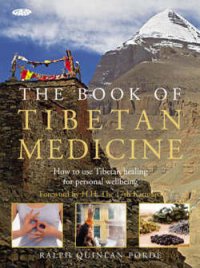
Tibetan medicine is a centuries-old traditional medical system that employs a complex approach to diagnosis, incorporating techniques such as pulse analysis and urinalysis, and utilizes behavior and dietary modification, medicines composed of natural materials (e.g., herbs and minerals) and physical therapies (e.g. Tibetan acupuncture, moxabustion, etc.) to treat illness. The Tibetan medical system is based upon a synthesis of the Indian (Ayurveda), Persian (Unani), Greek, indigenous Tibetan, and Chinese medical systems, and it continues to be practiced in Tibet, India, Nepal, Bhutan, Ladakh, Siberia, China and Mongolia, as well as more recently in parts of Europe and North America. It embraces the traditional Buddhist belief that all illness ultimately results from the „three poisons“ of the mind: ignorance, attachment and aversion. Read more: > Here <
The first illustrated guide to this holistic healing system, The Book of Tibetan Medicine, explains how the ancient Tibetan medical wisdom can be used to achieve spiritual well being in the modern world. Forward by His Holiness The 17th Karmapa.
Tibetan Medicine is an ancient medical system that has been successfully practiced for over 1,000 years and saved by His Holiness The Dalai Lama. A holistic approach combining dietary and behavioral changes, herbal cures, massage and meditation, this unique approach to healing utilizes the ancient wisdom of Tibetan masters. As well as the science of Tantric Buddhism.
http://thebookoftibetanmedicine.blogspot.com/ www.dharma-haven.org/tibetan/medicine-books.htm
The Book of Tibetan Medicine is now available in 11 languages worldwide. The forward has been written by His Holiness The 17th Karmapa. The book has been given excellent reviews by Shambhala Magazine, Mandala Magazine and Yoga Abode to name a few. The author is Ralph Quinlan Forde – Holistic Medicine Consultant – who is the founder of The Medicine Buddha Foundation.
KARMAPA IN EUROPE – YOGA OF MILAREPA
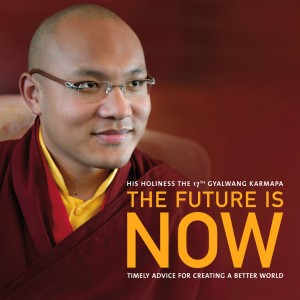
> www.chronicleproject.com – Talks on Milarepa <
> The Kagyu Tradtion – Milarepa <
The Karmapa (officially His Holiness the Gyalwa Karmapa) is the head of the Karma Kagyu, the largest sub-school of the Kagyupa (Tibetan Bka‘ brgyud), itself one of the four major schools of Tibetan Buddhism. The historical seat of the Karmapas is Tsurphu Monastery in the Tolung valley of Tibet. His Holiness‘ principal seat in exile is the Dharma Chakra Centre at Rumtek Monastery in Sikkim, India. His regional monastic seats are Karma Triyana Dharmachakra in New York, Dhagpo Kagyu Ling in France and Tashi Choling in Bhutan. Read More: > HERE <
Jetsun Milarepa (Tibetan: རྗེ་བཙུན་མི་ལ་རས་པ; Wylie: Rje-btsun Mi-la-ras-pa), (c. 1052—c. 1135 CE) is generally considered one of Tibet’s most famous yogis and poets, a student of Marpa Lotsawa, and a major figure in the history of the Kagyu (Bka‘-brgyud) school of Tibetan Buddhism. Read More: > HERE <
KAGYU & (Trad.) YOGA: Like all schools of Tibetan Buddhism the Kagyu consider their practices and teachings to be inclusive of the full range of Buddha’s teachings (or three yÄ�na) since they follow the fundamental teachings and vows of individual liberation & monastic discipline (Pratimoksha) which accord with the Mulasarvastivada tradition of the ŚrÄ�vakayÄ�na (sometimes called NikÄ�ya Buddhism or „HÄ�nayÄ�na“ ); the Bodhisattva teachings, vows of universal liberation and philosophy of the MahÄ�yÄ�na; and the profound means and samaya pledges of the Secret Mantra VajrayÄ�na. Read More: > HERE <
The central teaching of Kagyu is the doctrine of Mahamudra, „the Great Seal“, as elucidated by Gampopa in his various works. This doctrine focuses on four principal stages of meditative practice (the Four Yogas of Mahamudra).
Important practices in all Kagyu schools are the tantric practices of Chakrasamvara and Vajrayogini, and particularly the Six Yogas of Naropa.
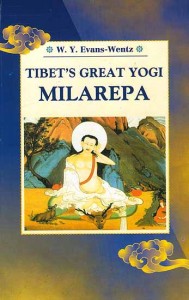
> BOOK : WWW.EXOTICINDIART.COM <
The Karmapas – Karmapa means „the one who carries out buddha-activity“ or „the embodiment of all the activities of the buddhas.“ In the Tibetan tradition, great enlightened teachers are said to be able to consciously arrange to be reborn as a teacher who can carry on the teachings of a predecessor in a prior life. Pursuant to this tradition, the Karmapas have incarnated in this form of manifestation body (Skt. nirmanakaya), for seventeen lifetimes, as of the present, and all have played the most important role in preserving and propagating the Buddhist teachings of Tibet.
Prior to the birth of the first Karmapa, the arrival of a Buddhist master who would be known as the Karmapa had been prophesied by the historic Buddha Shakyamuni and the great tantric master of India, Guru Padmasambhava. Throughout the centuries, Karmapas have been the central figure in the continuation of the vajrayana lineage in general and Kagyu lineage in particular, and have played a very important role in the preservation of the study and practice lineages of Buddhism. (For more on the Karmapas prior to the Seventeenth, see the section at this website on the Seventeen Karmapas.
VISIT OF HIS HOLINESS THE XVII.KARMAPA OGYEN TRINLEY DORJE TO EUROPE
Dear Dharma Friends, – I am sad to announce that the proposed visit of His Holiness the 17th Gyalwang Karmapa Ogyen Trinley Dorji was not approved by the Government of India. The visit was scheduled to take place from 27th May to 2nd July in nine countries of Europe. The Kagyu Office, the Administration of Gyalwang Karmapa was informed of the decision by the Tibetan Government in Exile on 3rd April 2010.
The process has begun to find out why this visit was not possible and what positive conditions are needed to make the visit possible in near future. I know a huge number of followers and friends in Europe were eagerly waiting for the visit of Gyalwang Karmapa and I know that all of you are sad and disappointed. I would like to take this opportunity to thank all the organizers, volunteers and donors for working so hard to prepare for the visit in last many months. Your cooperation and support were beyond any expectations. I hope and pray together with you that the visit will happen in very near future and that all of us would be able to receive his teachings in Europe.
Ringu Tulku,
Coordinator,
Karmapa’s Visit to Europe
- Researches in Indian and Buddhist Philosphy <
- Tibetan schools of Yoga:
- Anuyoga
- Mahayoga
- Six Yogas of Naropa
- Trul khor (Yantra Yoga)
- Ibn ‚Arabi Society Symposium, Ringu Tulku, Oxford College, 05/2010 <
- A Statement from the 17th Gyalwang Karmapa, Ogyen Trinley Dorje <
FREE Visa to India for MBA & Degree Programs, Jobs, friends at fb <
AJAM TULKU RINPOCHE IN BERLIN
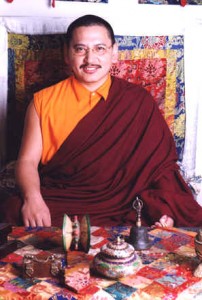
> PALYUL LING < > NAMDROLING <
Mahayana (Sanskrit: महायान, mahÄ�yÄ�na literally ‚Great Vehicle‘) is one of the two main existing branches of Buddhism and a term for classification of Buddhist philosophies and practice. It was founded in India. The name „MahÄ�yÄ�na“ is used in three main senses.
Although the MahÄ�yÄ�na movement traces its origin to Gautama Buddha, scholars believe that it originated in India in the 1st century CE,or the 1st century BCE.Scholars hold that MahÄ�yÄ�na only became a mainstream movement in India in the fifth century CE, since that is when MahÄ�yÄ�nist inscriptions started to appear in epigraphic records in India.Before the 11th century CE (while MahÄ�yÄ�na was still present in India), the MahÄ�yÄ�na sūtras were still in the process of being revised. Thus, several different versions may have survived of the same sūtra. These different versions are invaluable to scholars attempting to reconstruct the history of MahÄ�yÄ�na. Read More: >HERE <
BUDDHISMUS IN BERLIN in Kooperation mit dem TIBETHAUS BERLIN
AJAM TULKU RINPOCHE in Berlin – Zur Person: Tulku Ajam ist die Wiedergeburt des jüngeren Bruders von S. H. Drubwang Pema Norbu Rinpoche (Penor Rinpoche) und hat bis zu seinem 15. Lebensjahr in der Schweiz gelebt. Von Penor Rinpoche als eine Reinkarnation bestätigt, hat er seine intensiven Studien an der Klosteruniversität von Namdröl Ling in Südindien. Rinpoche lehrt in Deutsch!
2. April: Die Payul-Nyingma-Tradition (19-21h)
Von den vier Hauptrichtungen des Mahayana- Buddhismus in Tibet gehört die Nyingma-Tradition zu den ältesten Überlieferungen und lehrt die Anwendung des Dzogchen – i.e. „Die Große Vollkommenheit“, respektive die Lehre von der Verwirklichung der „Reinen Natur des Geistes“. Diese Überlieferung des Dzogchen reicht bis auf die Ursprünge des Buddhismus in Indien zurück und wurde zu Beginn des 9. Jahrhunderts n. Chr. insbesondere durch Guru Padmasambhava, nach Tibet gebracht.
Die Palyül-Tradition ist eine der Schulen der Nyingma-Tradition und zählt neben Kathok, Mindroling, Dzogchen, Shechen und Dorje Drak zu den sogenannten „Sechs großen Sitzen“ der Nyingma. Sie hat ihren Namen vom Palyül-Kloster im gleichnamigen Bezirk Palyül in Karze (tib.: dkar mdze), dem heutigen Sichuan, zurück. Der letzte Linienhalter der Payül Tradition war S. H. Drubwang Pema Norbu Rinpoche (Penor Rinpoche), Abt des Klosters Namdröl Ling in Südindien mit etwa 5000 Mönchen und Nonnen und der Lehrer von Ajam Tulku Rinpoche.
3.-4. April: Erklärung zu einem kurzen Namchö-Terma (Schatztext von Padmasambhava) über Meditiation (10-13h und 14h30-18h (Sonntag nur bis 16h30)
Tulku Ajam wird einen kurzen „Namchö- Schatztext“ (tib. terma) aus einer Sammlung von Unterweisungen von Padmasambhawa, der von den Tibetern liebevoll „Guru Rinpoche“ (wörtlich: Kostbarer Meister) genannt und als „Zweiter Buddha“ verehrt wird, kommentieren. Der Text enthält mündliche Anleitungen zur Meditation, die dieser im 9. Jahrhundert u. Z. während seines Aufenthalts in Tibet gegeben hat. Die essenziellen Unterweisungen wurden von seiner Schülerin Yesche Tsogyal in der verschlüsselten Geheimsprache der Dakinis dokumentiert und als kostbare Termas verborgen, damit sie zum späteren Zeitpunkt von den Tertöns, den (Wieder-) Entdeckern der Schatztexte, offenbart werden können. Guru Rinpoche hat die Namen der zahlreichen Tertöns und den Zeitpunkt ihres Auftretens prophezeit.
Dieser Text wurde vom großen Tertön Mingyur Dorje (1645-1667) entdeckt. Es heißt, dass die in Form von Schriften oder Visionen entdeckten Kernunterweisungen den Bedürfnissen der jeweiligen Zeit entsprechen und den Praktizierenden zukünftiger Generationen dienen.
Veranstaltungsort: Bodhicharya, Kinzigstrasse 25-29, 10247 Berlin
Kurssprache: Rinpoche wird in seiner Muttersprache, Deutsch lehren.
- Die Mittleren Stufen der Meditation <
- INTRO OF THE FIVE TRADITIONS <
- Techok Namdrol Ling Monastery, Four Noble Truths <
- Meet Buddhismus in Berlin, studies, friends at fb <
- Meet If your real interested in Buddhims or Buddhist at fb <
Yoga & Buddhism: Similarities & Differences
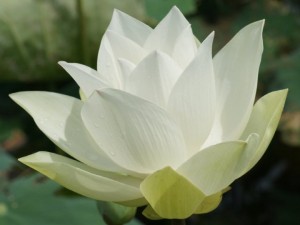
> TYS – Hindu, Buddhist, Jaina Yoga <
Yoga (Sanskrit, PÄ�li: योग yóga) refers to traditional physical and mental disciplines originating in India. The word is associated with meditative practices in Hinduism, Buddhism and Jainism. In Hinduism, it also refers to one of the six orthodox (Ä�stika) schools of Hindu philosophy, and to the goal toward which that school directs its practices. In Jainism it refers to the sum total of all activities—mental, verbal and physical.
Major branches of yoga in Hindu philosophy include Raja Yoga, Karma Yoga, Jnana Yoga, Bhakti Yoga, and Hatha Yoga.Raja Yoga, compiled in the Yoga Sutras of Patanjali, and known simply as yoga in the context of Hindu philosophy, is part of the Samkhya tradition. Many other Hindu texts discuss aspects of yoga, including Upanishads, the Bhagavad Gita, the Hatha Yoga Pradipika, the Shiva Samhita and various Tantras. Read More: > HERE <
Yoga and Buddhism: Similarities and Differences
Written by Dr. David Frawley
Yoga and Buddhism are sister traditions which evolved in the same spiritual culture of ancient India. They use many of the same terms and follow many of the same principles and practices. For this reason it is not surprising that many of us born in the West, particularly after an initial exposure, are apt to regard Yoga and Buddhist teachings as almost identical.
We may want to combine their teachings or practices accordingly, as if there were no real differences between them. The differences that have existed between the two systems historically, which have kept them apart as separate traditions, are less obvious to us in the West than are their commonalities. Or those who study one of these traditions may be inclined to see the other as a borrowing from it. Those who study Buddhism may find so much similarity in Yoga that they suspect a strong Buddhist influence on Yoga. Those who study Yoga may find so much similarity in Buddhism that they see a strong yogic influence on Buddhism.
However, the tendency to find commonality between these two great spiritual traditions is not limited to the West. Swami Vivekananda, the first great figure to bring Yoga to the West, examined the Buddhist Mahayana scriptures (Sutras) and found their key teachings and those of Vedanta that he followed to be ultimately in harmony. In recent years with the influx of Tibetan refugees into India, including the Dalai Lama, there has been a new dialogue between the two traditions that is bringing about greater respect between them. Tibetan Buddhists often appear at Hindu religious gatherings and partake in all manner of discussions.
Nor is the attempt to connect the two traditions limited to modern times. Various synthetic Hindu-Buddhist teachings have existed through history. Buddha himself was born a Hindu and some scholars have argued that Buddhism as a religion apart from Hinduism did not arise until long after the Buddha had passed away. A Shiva-Buddha teaching existed in Indonesia in medieval times, and for many Tantric Yogis it is difficult to tell whether they were Hindus or Buddhists. Buddha became accepted as an avatar of Vishnu for the Hindus during the medieval period, and most Hindus still consider that we live in the age of the Buddha-avatar. Most Hindus accept Buddha as a great teacher, even if they do not accept all Buddhist teachings. Full Article: > HERE <
- Meet Buddhism studies, groups, friends, at fb <
- Meet Hinduism studies, groups, friends, at fb <
- Meet Jainism studies, friends, fans, at fb <
- Meet Dr. David Frawley, AIVS, studies, friends, at fb <
- Meet Traditional Yoga Studies, friends at fb <
Researches in Indian and Buddhist Philosphy
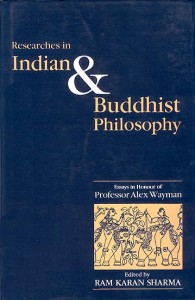
> Chap16: Comp. Siddis in Bhagavata Purana & Patanjali Yoga Sutras <
> BOOK: SIDDHIS IN THE BHAGAVAD PURANA <
Siddhi (Devnagari सिद्धि) is a Sanskrit noun that can be translated as „perfection“, „accomplishment“, „attainment“, or „success“. The term is first attested in the Mahabharata. In the Pancatantra, a siddhi may be any unusual skill or faculty or capability. As a legal term in the Manusmriti, it refers to the settlement of a debt.
In the Samkhya Karika and Tattva Samasa, and hence in Tantric Buddhism, it specifically refers to the acquisition of supernatural powers by magical means or the supposed faculty so acquired. These powers include items such as clairvoyance, levitation, to be present at various different places simultaneously, to become as small as an atom, to materialize objects, to have access to memories from past lives, etc. The term is also used in this sense in the Sarvadarsana-samgraha of Madhvacharya. Read More: > HERE <
Researches in Indian and Buddhist philosophy:
Essays in honour of Professor Alex Wayman, RÄ�ma Karaṇa ŚarmÄ�
The present volume, comprising ninteen articles by renowned scholars, is divided into three sections, namely, Buddhist Jaina and Hindu Philsosphical Researches. The articles in Hindu section take a comperative base. K.K.Raj compares the Buddhist and Mimamsa views on Laksana. K. Bhattacharya speaks of grammarians and philososphers regarding post-Panini grammarians on a certain anusasana. R.C.Dwivedi compares kashmir Saivism with Sankara`s Vedanta and T.S.Rukmani compares Siddhis as found in the Bhagavata Purana and in Patanjali`s Yogasutras. R.V. Joshi compares the Advaita and the Vaisnava views of the matter.
The present volume, comprising nineteen articles by renowned scholars, is divided into three sections, namely, Buddhist, Jaina and Hindu Philosophical Researches.
Under the Buddhist section Bareau, using the Vinaya in Chinese, defends Wayman’s position that Asanga belonged to Mahisasaka sect. Nakamura points out differing view about the seven Vajjian Republic principles. Michael Hahn and Samtani concern with Buddhist poet Candragomin and the term raga resectively. Shinjo Kawasaki expounds the views of Bhavya about the differing karma of non-sentient and sentient beings. Hirakawa’s article deals with the relation with dhatu. Collett Cox shows that the present 12-membered formula is taken for granted by early Chinese Abhidharma texts.
In Jaina section, Jaini deals with the theory that an omniscient being can subsist on a subtle kind of food. Dhaky’s main object t ascertain early parts of Dasavaikalikasutra, also goes into the matter of food.
The articles in Hindu section take a comparative base, K.K. Raja compares the Buddhist and Mimamsa views on Laksana. K. Bhattacharya speaks of grammarians and philosophers regarding post-Panini grammarians on a certain anusasana. R.C. Dwivedi compares Kashmir Saivism with Sankara’s Vedanta and T.S. Rukmani compares siddhis as found in the Bhagavata Purana and in Patanjali’s Yogasutras. R.V. Joshi compares the Advaita and the Vaisnava views of the matter.
The work breaks new grounds and is a solid contribution in the field of Indian Philosophy.
About the Author – Prof. R.K. Sharma as a Fulbright Scholar, worked with Prof. M.B. Emeneau at University of California. He has all along been contributing to promotion of Sanskrit Studies in India and abroad as Founder Director, Rashtriya Sanskrit Sansthan, Joint Educational Adviser, Govt. of India, Vice-Chancellor of the two Sanskrit Universities at Darbhanga and Varanasi, Visiting Professor at Columbia University of New York City, University of Bihar and Chicago, Organizing Secretary of two world Sanskrit Conferences, etc. He is a recipient of Presidential Award of Honour in Sanskrit and a Fellow of the Royal Asiatic Society.
Yogis in Tibet
Instructions On Siddhis
1. By the process of Hatha Yoga, the Yogi attains perfect physical body—Rupalavanya Bala Vajrasam-hanana Kaya Sampat. “The perfection of the body consists in beauty, grace, strength and adamantine hardness.” The power to bear extreme cold and heat (Titiksha), the power to live without water and food and other powers come under the category of Kaya Sampat (perfection of body).
2. Since the body of the Hatha Yogi is perfect and firm, his mind also is firm and one-pointed. By the practices of Dharana and Dhyana, he reaches the highest rung in the Yogic ladder and attains Immortality through Yogic Samadhi. The Yogi who has reached the highest stage, will have the 8 major and all the minor Siddhis.
3. Attainment of powers depends upon the amount of concentration at different Chakras and Tattvas and awakening of Kundalini. The practice of Mudras, Bandhas, Asanas and Pranayamas will also help a lot in acquiring Siddhis.
4. The Siddhis that are obtained by the practice of Mudras can be obtained by the practice of Bandhas, Asanas, Pranayamas and also by the concentration on different Chakras. That depends upon the temperament and capacity of the aspirants. One can obtain the desired goal by one exercise and others by different methods. Therefore if one is not able to get success by a particular exercise, he will have to have recourse to other exercises.
5. Many of the 8 major Siddhis are not possible at all at the present age (Kali Yuga), when the body and mind of the vast majority are not fit enough. Even today there are several Siddhas who have the power to perform some of the Siddhis. When people approach them to do this and that, they hide themselves or generally say:—“I do not know.” They are not much particular about these Siddhis. Their aim is to ignore these as unreal and aspire to reach the highest. They are the only real Yogins. Many are able to use some powers and they do not know how they are able to do them.
6. One can read the thoughts of others. A man in London hears the spiritual message of sages in India. You have seen several persons removing the poison of cobras by chanting some Mantras or by mere touch. By giving some sort of leaves, incurable diseases are cured. There are men who will very accurately tell your past, present and future. Some are able to see astral entities. Stopping the functions of the heart and changing the mind of others and other powers are due to Yogic practices.
7. Nowadays you cannot find a man who has developed all the powers. When one gets certain powers, he stops there by the influence of Maya and false Tushti (satisfaction) and uses the powers for his livelihood or for fame. Therefore he is not able to proceed further and attain perfection. It is not the mistake of the Yogic Kriyas. You should not lose faith. Faith, attention, sincerity and earnestness will lead you to success.
“ Of one thing we can be certain. The real Siddha who does not want or care for Siddhis, but who manifests Siddhis for unselfish reasons and as a result of communion with the Lord or the Brahman, is an entirely different person from the little man who has psychic powers to do things which are extraordinary or who has control of spirits. The power over spirits (good or bad) is entirely different from spiritual power. And no real Siddha goes about calling himself a Bhagavan or parading his powers. It cannot be said that the Siddha does not know that he performs miracles but they are not miracles to him—they are just ordinary things for him because he lives in the plane beyond the reach of the common man. I have to conclude that Swami Sivananda is one such. But he does not reveal himself as such to all and sundry.“ – Sri Swami Sivananda
- Also read from Kundalini Yoga- SRI SWAMI SIVANANDA
- KUNDALINI
- INTRODUCTION
- YOGA SADHANA
- PRANAYAMA
- PRAYER TO MOTHER KUNDALINI
- EXPERIENCES ON AWAKENING OF KUNDALINI
- GRADATIONAL ASCENT OF MIND
- PRANAYAMA FOR AWAKENING KUNDALINI
- ASANAS
- MUDRAS AND BANDHAS
- EIGHT MAJOR SIDDHIS
- DHARANA
- YOGA-KUNDALINI UPANISHAD
- Tibetan schools of Yoga:
- Anuyoga
- Mahayoga
- Six Yogas of Naropa
- Trul khor (Yantra Yoga)
Act4Tibet – Yogi Tsoru Dechen Foundation

Yogi Tsoru Dechen Foundation, Florida
The Yogi Tsoru Dechen Rinpoche Foundation was created to provide Westerners access to the Buddha Dharma (Path of Awakening), and to supply Compassion and Wisdom to all human beings. The founder and spiritual leader of YTDR Foundation is Tulku Karma Gyurme Sonam Rinpoche, who is recognized as a Lama – a term reserved for senior members of the Tibetan Order.
ACT is a branch of the Yogi Tsoru Dechen Rinpoche foundation that is dedicated to helping the young Tibetan refugees and monks at Lama Tulku Karma’s camp in Mainpat, India.
Acupuncturists from Sedona treat Tibetans living in exile in a Tibetan refugee camp in India, called Mainpat. Invited by buddhist lama Tulku Karma Rinpoche, the experience so moved them that they formed the Tibetans in Exile Health Project, a not for profit tax exempt organization committed to meeting the health care needs of Tibetans living in exile.
YTDR manages several charitable programs which directly benefit the people of Tibet and help ensure the survival of their culture. The Foundation’s ultimate vision is to have Dharma Centers established throughout the world devoted to cultivating wisdom and compassion for all beings.
With Dharma Centers already established in Nepal and the US, these additional centers will sustain the teachings and unique lineage of Tibetan Buddhism that was nearly extinguished in the political upheavals of the 20th century, and which have been re-established while still in exile.
YTDR Foundation is a volunteer based organization, and is a registered Florida Charitable Entity EIN 30-0458849 that has applied for Federal Non-Profit Status.
Meet YTDR Sedona Dharma Center, friends, fans at fb <
Meet Act4Tibet, friends, fans at fb <
Indo Tibetan Yogic Tradions of the 5 Rites
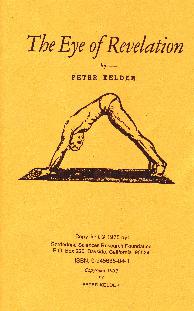
> The Indo-Tibetan Tibetan Yogic Tradition <
and the “Tibetan Rites of Rejuvenation”
The Five Tibetan Rites is a system of exercises reported to be more than 2,500 years old which were first publicized by Peter Kelder in a 1939 publication entitled „The Eye of Revelation“. Although practically nothing is known about Kelder, one source reports that Kelder was raised as an adopted child in the midwestern United States, and left home while still in his teens in search of adventure. In the 1930s, Kelder claims to have met, in southern California, a retired British army colonel who shared with him stories of travel and the subsequent discovery of the Rites. Originally written as a 32-page booklet, the publication is the result of Kelder’s conversations with the colonel.The Rites are said to be a form of Tibetan yoga similar to the more well-known yoga series that originated in India. However, the Five Rites and traditional Tibetan yoga both emphasize „a continuous sequence of movement“ ( Sanskrit: vinyasa ), whereas Indian forms focus on „static positions“. Although the Rites have circulated amongst yogis for decades, skeptics say that Tibetans have never recognized them as being authentic Tibetan practices.
The Five Tibetan Rites are also referred to as “ The Five Rites „, “ The Five Tibetans „, “ The Five Rites of Rejuvenation “ and most recently “ T 5 T „. Read More: > HERE <
Disputed origins – Although the origin of the Five Rites prior to the publication of The Eye of Revelation is disputed between practitioners and skeptics, a comparison of illustrations of the postures shows a remarkable similarity between the Rites and authentic Tibetan ‚phrul ‚khor exercises from a system rendered into English as ‚Vajra Body Magical Wheel Sun and Moon Union‘ (Tibetan: རྡོ་རྗེ་ལུས་ཀྱི་འཕྲུལ་འཁོར་ཉི་ཟླ་ཁ་སྦྱོར; Wylie: rdo rje lus kyi ‚phrul ‚khor nyi zla kha sbyor).
Chris Kilham, whose 1994 book The Five Tibetans helped respark the Five Rites‘ popularity, says, „As the story has it, they were shared by Tibetan lamas; beyond that I know nothing of their history.“Even though the historic lineage of the Rites prior to the publication of Kelder’s booklet remains to be ascertained, the Rites have nevertheless been affirmed by a lama and scholar of the Sa skya tradition of Tibetan Buddhism as being „a genuine form of yoga and were originally taken from an authentic Indo-Tibetan tantric lineage, namely a cycle of yantra-yoga associated with the Sadnadapadadharma.“ These techniques have been integrated into the well-known > “Six Yogas of Naropa”< (Sk. Sadnadapadadharma षड्नादपादधर्म Tib. na ro chos drug ན་རོ་ཆོས་དྲུག་).
However, it has been argued that the Five Rites predate yoga as we know it today by as much as seven hundred years or more and, therefore, could not have derived from either Tibetan or Indian forms of yoga. Moreover, it has also been suggested that the Rites are more likely to have originated from a system of Kum Nye which, like the Rites, date back 2,500 years.
Nevertheless, Chris Kilham also states that “ the issue at hand, though, is not the lineage of the Five Tibetans. The point is their immense potential value for those who will clear 10 minutes a day to practice.“
Tibetan Buddhism Trul Khor, by Tenzin Wangyal Rinpoche
Records of Teachings Received by Tibetan Masters from the Sa skya Tradition – A Project of the University of Munich in collaboration with the Tibetan Buddhist Resource Center (New York), funded by the German Research Foundation (DFG):
About the Database: The „Records of Teachings Received“ (gsan yig) from which the entries of this database originate, form part of the collected writings of the renowned Sa skya pa master and historian A mes zhabs Ngag dbang kun dga‘ bsod nams (1597-1659).
This database contains references to almost 1,800 individuals (references to some of whom were previously scarce or non-existent) listed in 746 lineage records. Read More: > HERE <
Kum Nye and sKu-mNyé refer to a wide variety of Tibetan religious and medical body practices. The two terms are different spellings in the Latin alphabet of the same Tibetan phrase (Wylie: sku mnye), which literally means „massage of the subtle body“. Some systems of sku mnye are vaguely similar to Yoga, Tai Chi, Qi Gong, or therapeutic massage. Confusingly, „Kum Nye“ and Ku Nye are also used to transcribe the Tibetan phrases dku mnye („belly massage“) and bsku mnye („oil massage“), which are pronounced identically to sku mnye. dKu mnye and bsku mnye manipulate the physical body, rather than the subtle (energetic) one.
Systems of Kum Nye are found in many Tibetan Buddhist and Bön traditions. These can be entirely different both in purpose and in methods. For instance, some forms are very slow moving; others are intensely aerobic. Some systems are based in the Tibetan Medical Tantras (scriptures), and are mainly therapeutic. Other systems are based in Dzogchen, and are mainly religious in purpose. Read More: > HERE <
N�rop� or Naropa (Prakrit; Sanskrit: N�ropad�, 956-1041) was an Indian Buddhist yogi, mystic and monk. He was the disciple of Tilopa and brother, or some sources say partner and pupil, of Niguma . Naropa was the main teacher of Marpa, the founder of the Kagyu school of Tibetan Buddhism. As an Indian tantric Buddhist, he has a place in Vajrayana Buddhism as a whole, but he is particularly renowned in Tibetan Buddhism via his name being attached to the six yogas of Naropa, a suite of advanced yogic practices for the attainment of skills relevant to the completion stage of anuttarayogatantra.
Naropa was born a high status Brahmin but from an early age showed an independent streak, hoping to follow a career of study and meditation. Succumbing to his parents wishes, he agreed to an arranged marriage with a young brahmin girl. After 8 years they both agreed to dissolve their marriage and become ordained.
At the age of 28 Naropa entered the famous > Buddhist University at Nalanda < where he studied both, Sutra and Tantra.
He gained the reputation as a great scholar and faultless debater, essential at that time as the tradition of debate was such that the loser automatically became a student of the winner. He eventually gained the title „Gatekeeper of the North“; engaged in many debates, taught and won many students. Read more: > HERE <
-
Articles:
-
Booktipp: > Eye of Revelation: (Paperback) <
-
Umbrella Association: > Die Fünf Tibeter Dachverband ® e.V. <
YOGA, TREE AND OUR UNIVERSE
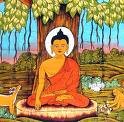
The Originar of Hatha-Yoga
Tree is the highest evolved form in plant kingdom. Man is the highest evolved species in Animal kingdom. Mushrooms are the best fungi visible on this planet. There is commonality of forms among all these highest evolved forms among different type of life-forms -Tree-like structure.Man is a cerebro-spinal being sheathed within a fleshy body. Most evolved form of cell is neuron that mediates consciousness is Tree-like structure. Surprisingly, most powerful thing that mankind achieved viz. atom bomb , produce Tree-like clouds after exploding on the surface.
Tree-like structure in Nature!
One can find out where else do Tree-like structure in nature exist. Pliny, the Younger linked the eruption of Vesuvius eruption in 79 A.D. with Italian umbrella pine. It is now an established scientific fact that the most powerfur process within earth, volcanic plumes that move inside earth is umbrella-shaped with a column & umbrella spinning about vertical axis( Tree-like). The most terrible force on the surface of the earth are the Tornados which are again Tree-like shapes with a column & an umbrella. Tree-like shape is found in other very powerful phenomena like lightening flashes, electric sparks, river delta, snowflakes, coral .
Tree-like structure is characteristics of every visceral system. Biologists trace this form in the mosses, lichens, shrubs, root system, mammalian lung bronchioles, cells of nervous system, veins & arteries forming cardio-vascular system. Wheresoever there are branching system, that invariably culminate in a Tree-like structure.
Tree & Fractal Geometry
In last fortnight, a brilliant paper was published in ‚Advances in Soft Computing“, under the title“Algorithms for Tree-like Structure Generation“ by Anna Romanowska, a neuro-anatomist et al. The team characterised Tree-like structure as that form which bifurcates but do not form any cycles. The team picked up the concepts of fractal geometry & fused with algorithms to create a Recurrent Algorithm. Self-similarity and repetition of sequence( iteration) is generated by a bifurcating cascade. The team concluded that if living system are generated recurrently, complex organic structures like roots, bronchial system in lungs emerge.
Now that an algorithm for Tree-like structure has been generated, it will be feasible in a decade to manufacture on mass scale silicon bronchial/ cardio-vascular/ neural system .
Before the advent of Fractal geometry by Benoit Mandelbrot during 1970s, the question of Tree-like structure had perturbed many a great minds. Hisao Honda of University of Kyoto published a paper on “ Description of the Form of Trees by the parameters of the Tree-like body“ in the Journal of Theoretical Biology, May, 1971. Honda concluded that Tree architecture maximizes flow access. He found stastitical similarity in living & non-living world, among branching in living system & geological & geophysical system.
- Meet Swami SIVANANDA friends, yoga, studies, at facebook <
- Meet Bhagavad Gita friends, yoga, studies at facebook <
- Meet Patanajali friends, yoga, studies at facebook <
- Meet Buddhism, friends, studies, Medicine at facebook <
- Meet Paramahansa Yogananda friends, groups, studies at fb <
- Meet Raja Yoga, Friends, Group, studies at facebook <
- Meet IYENGAR (B.K.S.), Yoga, Friends, Studies, Groups at fb<
- Meet Swami Vivekananda, Yoga, Studies, Friends, Groups at fb<
- Meet Bhagavad Gita, Yoga, Studies, Friends, Groups at fb <
- Meet Ramana Maharshi Groups, Friends, Studies, Fans at fb<
- Meet Hinduism, Groups, Friends at facebook <
- Meet Kashmir Hinduism, Studies, Friends at facebook <
- Meet Shaktism and Devi the Godess at facebook <
- Meet Saundaryalahari: Wave of Bliss by Shankaracharya at fb <
- Meet Arsha Vidya Gurukulam, Studies, Friends, Fans, at fb <
- Meet Advaita Vedanta,Groups,Studies, Vivekananda at fb <
- Meet Yogi Yogendra Nath, Studies about Goraksha at fb <
- Meet Jaya Kula and the three ways of Practicing tantra at fb <
- Meet VASTU, Friends, and Study Groups at facebook <
- Meet Jyotish, Friends, and Study Groups at facebook <
- Meet Sacred Geometry at facebook <
- READ MORE HERE:
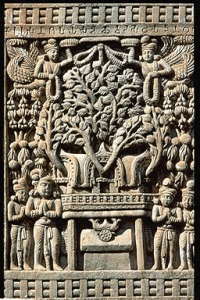
Morphic field & Morphic Resonance!
Tree-form is found in lower kingdom of Animal as well as Fungi. Jelly fishes or the polyp, these are invariably shaped like Trees. The colonies of proliferating marine organism replicate this form. It is interesting that jellyfishes which have no neurons & man with maximum neurons are essentially same in shape. Great Scottish biologist, Sir D’Arcy Thompson wrote in 1917 „On Growth and Form“, to analyse patterns & shapes in nature. His erudite tradition sd being carried by Rupert Sheldrake, a British biologist. He has done extensive work on the concept of morphic field & morphic resonance. By morphic resonance, he explains the influence of Like upon Like by which a connection among similar fields is established. He has shown in his work example of crystallization. It is very difficult to crystallize a new compound for the first time. Once it is done, a morphic field emerge. It is easier next time if someone does elsewhere in the world. There is a cumulative influence & it gets easier & easier to crystallize the compound. There is an accelerated rate of crystallization . Similarly, in learning among rats, this phenomena has been experimentally confirmed. It is difficult for a rat to pass through a maze for the first time. But, once a rat does this, another rat elsewhere does it much easily. And with each learning , there is spontaneous spread of new habits. For Sheldrake, evolutionary spread of new habit is not genetic but depends on a kind of collective memory due to morphic resonance.
This can be easily comprehended in case of human. It was very tough to manufacture clock or VCD or computer. More people are manufacturing, easier it is getting to manufacture. Watches, transistora & VCDs are now cottage industry. Who knows in future, robotics will emerge as similar kind of easily handled industry and there will be garages in every nook & corner of city to repair robots or even remodell robots by neighbourhood mechanic.
Sheldrake further proposes the concept of the „Memory of Nature“. Habits of nature depend on non-local similarity reinforcement. Through morphic resonance, the pattern of activity in self-organizing system are influenced by similar patterns in the past. He brings back the idea of Carl Jung‘ collective unconscious.
Examining Growth of Tree-Form!
I find the concept of morphic resonance appealing. That can explain this frequent recurrnce of similar pattern in nature. If we ponder over the shape of DNA & its future. The fluid around earth’s inner core creates a helical movement and generates magnetic field. The geodynamo of the earth is a self-replicating system that help explain the continuity of magnetism in earth’s core , otherwise it would have dissipated within 20,000 years. Now, the transformatory biological molecule,DNA, is helical as well as self-replicating. Within geo-physical processes, we know that Tree-like plumes are created. Now, this geophysical structure resonates throughout future evolution of biological world. For every plume within, there is a tornado on the surface. This first form of powerful process recurs at the level of the most developed categories at various levels, may it be fungi, or plants or animals or cells. And, that form recurs in even man-made powerful processes like atomic explosions.Upon visualizing this sequence, I can very well predict that the most successful biological robots or most efficient spaceship for planetary travels would have Tree-like architecture. Our Discovery spaceship is a poor materialization of that critical architecture.
Tree & bifurcation!
This Tree-like structure itself is generated by recurrent self-similarity which results due to behaviour of a dynamic system. Now, the chaos theorists have worked out very well that how in a dynamic system , a stage of crisis is set in and at the point , there are two possibilities for the system to transform. Sometimes, the system oscillates between two possibilities as found in certain chemical clocks extensively investigated by Nobal laureate Ilya Prigogine.Most of the times, the branches grow further and then bifurcate. This is iteration of self-similarity that later results into Tree-like structures.
If this kind of bifurcaing iteration is fundamental to our changing Reality which is dynamic, and there is morphic resonance, one can draw the contours of this phenomena of emergence of Tree-like structure at a higher level.
End of biological evolution!
The bifurcation, that determines DNA-replication to cell-division, has finally achieved its destiny in the biological world in the form of Human beings. We are the highest biological form and the biological evolution has now concluded. There is no further scope of biological evolution beyond us.Perfect biological bifurcating branching system has been achieved. Our lungs, our cardio-vascular system, neural system .. everything has emerged as mere consequence of cascading bifurcation. Surprisingly, we have greater number of most evolved cells viz. neurons (200 billions) which themselves replicate own form at macrolevel. The cerebro-spinal system is a magnified neuron. We are the only animal to walk on 2 legs. Penguins do perform but lack other binarities. We have two legs, two hands, two nostrils, two ears, two testicles, two mammary glands, two eyes, two kidneys, two hemispheres in brain, two atrium, two ventricles in heart, two excretory points, two lips, two jaws. Our thinking pattern is also binary. Our categories are in twos- good/bad, high/low,sacred/profasne, self/other… We donot yet understand that this duality in thought is rooted in hemispheric brain or in fractal geometry. There is no more bifurcation & branching possible in bodily architecture of human beings. This is the end-point of biological evolution. Now, mankind is on verge of developing biological robots & higher order machine consciousness therby imbuing consciousness to physical world bypassing the biological evolution. We are becoming the co-creator of the Universe as well as agent to accelerate self-consciousness of physical matter in the universe.
Trees are our cousin!
Now, the issue of Tree-like structure resonates into our collective psyche. Tree is the source of wisdom, healing, nourishment, power. Bible myth has Tree . Newton discovered moodern science sitting under an apple Tree. Buddha discovered non-theistic self-awareness sitting under a peepul Tree. In Tibetan tradition, powerful meditation requires visualizing Tree of lineage with various Gurus on different branches. These kind of visualization has transformative effect on our consciousness. In every culture, Tree occupies a significant position in rituals & mythology. We feel special feeling with Tree. Our romantic mood, our wisdom, contemplative mood, aesthetic mood.. orbit around physical & metaphoric Tree. Tree have power to transmit some kind of healing power to us. Tree are the source of healing body through fruits & herbal medicine . Tree heals our body, mind as well as soul, if any. The processes involved may be a kind of morphic reonance that vitalizes self-similar cardio-vascular, respiratory & neural system.Trees are our morphic cousins. We feel guilty & hurt when trees are cut or when those are under environmental threat.
Future?
One thing is certain. Future robots & spaceships which would be most efficient to survive would have Tree-like architecture. We would have very little to do with blooming of age of nanotechnology, biotechnology & Artificial intelligence. Successful creation of algorithm for Tree-like structure has made it more likely that artificial human organs can be manufactured at industrial level. When death will be conquered after successful download of Memories & large scale diffusion of bionics, We would have enough time to resonate with biological Trees in solitude & steer mankind towards a spiritual evolution as biological evolution from DNA-pathway has reached a dead end!
(Niraj,1.11.2009)
Gross Elements in Ayurveda, Yoga, Buddhism
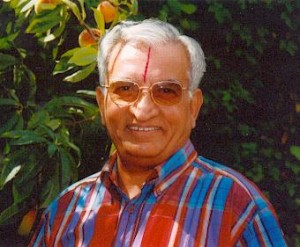
> Principle of Tridoshain Ayurveda <
MahÄ�bhūta is Sanskrit and PÄ�li for „great element.“In Hinduism, the five „great“ or „gross“ elements are ether, air, fire, water and earth. In Buddhism, the „four great elements“ (Pali: cattÄ�ro mahÄ�bhūtÄ�ni) are earth, water, fire and air. Read more: > HERE <
The Principle of Vata, Pitta and Kapha
The Physiology of Âyurveda is the physiology of the all-important trio, Vâta, Pitha and Kapha or Tridosha as they are generally called. Anybody, even faintly acquainted with Ayurveda, must have frequently come across the terms Vâyu, Pitha and Kapha. But very few have any clear idea of what is really meant by the terms. Every grown-up Indian has some vague idea about Vayu, Pitta and Kapha, and the terms are also used in common parlance. But in the majority of instances, the popular conception is quite different from the medical one. We have ample reference in Ayurvedic literature to the properties and different functions of Vatu, Pitta and Kapha, both in their normal and abnormal conditions. But we have no direct evidence by which we can come to a definite conclusion regarding the ultimate nature of these three substances. All that we can do is to make some inference based on reason, by a comparison of the original texts of Charaka, Sushruta and others and supplemented by such evidence as we can get from non-medical sources.
Yet Vâtha, Pitha and Kapha are the three entities on which stands the whole foundation of Ayurveda; we have to deal with them from the beginning to the end. Without their proper knowledge, successful treatment of diseases according to the Ayurvedic System is quite impossible. Before proceeding further, it is necessary that we should know something of the conception of the ancient Hindus regarding the physical world. Charaka and Sushrutha have mainly followed the Nyâya-Vaisheshikha and Sâmkhya-Yoga systems of Philosophy and occasionally the Vedanta view of the five Bhuta.
The nature and Physical Properties of the Tridosha.
The fundamental principle underlying the Ayurvedic System of Medicine is that of the Tridosha. In a nutshell, this Principle may be stated as follows:
There are three Dosha, Vâyu, Pitta and Kapha, which when in equilibrium keep the body sound, but which when vitiated, either singly or in combination, bring about diseases. The method of treatment would therefore be to bring the vitiated Dosha back to normal state, so that the three Dosha are again in equilibrium. We have seen that Âyurveda developed from the four Vedas; it is also regarded as a supplement of the Atharva Veda. But nowhere in the four Vedas can we find any specific mention of these substances.
It is in the Rig Veda only (1.3.6) that we find what may be regarded as the root idea of Vâyu, Pitta and Kapha :
“Tri-no asvinÄ� divyÄ�ni bhesajÄ� trih pÄ�rthivÄ�ni trirudattamadvyaha;
Om�nam samyor-manma k�yasunave tridh�tu sarma vahatam subhaspat�.
Here “tridhÄ�du sarma vahatam” has been explained thus by the commentator SÄ�yana: That is to say that when the three Dhâtu – Vâyu, Pitta and Kapha – remain normal and undisturbed, the body is at ease and there is no disease.
With the advancement of the knowledge, when the science of medicine was systematically studied, Âyurveda as a separate and special subject evolved out of the Vedas. The Principle of Vâyu Pttha and Kapha, was then fully developed and so we find copious reference to these terms in the Mahâ Bhârata and Upanishads.
Draya explained:
Dravya is defined as „that which contains in it action and quality and is a co-existent cause“. (C. S. I. 1.50 ; V. S. I. 1. 15). Substances exist and have qualities. We have two kinds of qualities, those which reside in a plurality of objects and those which are confined to individuals. The former are the general qualities (sâmânya), while the latter are distinguished as permanent (guna) and transitory (karma). Inherence is a special kind of relation. Relations are of two kinds. external like, conjunction (samyoga), or internal like inherence (samavâya). The first is regarded as a quality and the second is made a separate category.
The Vaisheshika believes that a substance is something over, and above the qualities. It is anxious to assert the existence of something which has qualities without being itself a quality, for we predicate qualities of substances and not qualities of qualities. Nor can it be said that we predicate one quality of a group of qualities. But since a substance cannot be conceived apart from qualities, it is defined as possessing qualities.
Qualities and action exist by combination with substance. Without substance, there were no qualities or action. Similarly, genus and species are correlative and are not absolute, except in the case of the highest genus which is Existence (bhâva) and the lowest species which is vishesha or individual characteristics appertaining to and inhering in the external substances. Genus and species, therefore, exist by combination with substances. Without substances, there were no genus and species. Similarly Samavâya or combination is “the intimate connection in the inseparably connected things“, e.g. parts and wholes of substances and their qualities, of action and the seat of action of genus and species and substances in which they reside, and of external substances and their ultimate differences. Without substance, then, there were no combination. Substance or dravya, therefore, is the fundamental reality.
Dravyas are nine in number, viz. the five Bhutas,
- 1. Prthivi (Earth)
- 2. Apah (Water)
- 3. Tejas (Fire)
- 4. Vâyu (Air)
- 5. Âkâsha (Ether
and
- 6. âtman (Soul)
- 7. Manas (Mind)
- 8. Dish or dik (Space) and
- 9. Kâla (Time).
These nine substances are intended to comprise all corporeal (murta) and incorporeal (a-murta) things. Ether, time and space are all-pervading, have the largest dimensions and are the common receptacles of all corporeal things. Soul and mind, Ether, time and space, Air and the ultimate atoms are not ordinarily perceptible, (V. S. VIII. 1.2).
[It must be clearly understood here that whenever we use the terms Earth, Water, Fire, Air and Ether, we use them only to denote the five bhutas and not in the sense of ordinary earth, water, air, fire or ether]
Charaka says that dravyas are of two varieties, – animate and inanimate. Those endowed with the senses are called animate; those devoid of senses are inanimate, (Sendriyam cetanam dravyam, nirindriyam acetanam, C. S. I. 1. 47.)
The Nature Of Citta According To The Yogasutras Of Patanjali
The five Mahâbhutas
The five Mahâbhuta originate from the five Tanmâtra. Of these, the Prthivi helps the other four by being their support. Ap helps the other four by moistening. Tejas helps the others by ripening. Marut helps by drying and Akâsha helps the other four by giving space. Prthivi is possessed of five qualities, – sound, touch, colour, taste and smell. Ap is possessed of four qualities,- sound, touch, colour and taste. Tejas is possessed of three qualities, sound; touch and colour. Vâyu is possessed of two qualities, – sound and touch. Akâsha has only one quality, sound.
We thus get :
Âkâsha/ Aether – (Sound-essence)
Vâyu/ Air – (Sound + touch)
Tejas/ Fire – (Sound + touch + colour)
Ap/ Water – (Sound + touch + colour + taste)
Prthivi/ Earth – (Sound + touch + colour + taste + smell).
Though Earth contains a number of qualities; we yet say that it has smell, on account of the predominance of this quality. If water and other substances besides earth possess smell, it is because particles of Earth are mixed up with them. We cannot think of Earth without smell, though we can so think of air and water. The special quality of Water is taste. Fire has for its special quality luminosity. Air is invisible, though limited in extent and made up of parts. The discrete nature of Air is inferred from the movements in the air, which would not be possible were Air an absolute continuum devoid of parts (V. S. II.1.14). Its existence is inferred from its special quality of touch and it is said to be a substance, since it possesses quality and action.
According to the Vaisheshika, the ultimate constituents of the concrete things of earth, air, fire and water are called paramânu or atoms.
Charaka has pointed out the primary qualities or special physical characters, of the five Bhuta in a different way. He says, „The characteristic of Earth is roughness, that of Water liquidity, of Air expansion, of Fire heat and that of Ether non-resistance. All these qualities are perceived through the sense of touch,“ -„Sparshendriya gocharam“, (C. S, IV. 1,27 ).
Bhutas are not elements
The Bhuta has been translated as ‚element‘. This is misleading. Bhutas are not elements and paramânus are not atoms or molecules in the modern sense of the terms. Modern writers laugh at the idea of calling the earth, water, fire, air and ether elements, ignoring the fact that a Bhuta is just an element, in the chemical sense of a substance that cannot be further analysed. „On referring to any Vaisheshika manual, it will be clear that what is ordinarily known as ‚earth‘, is not regarded by the Vaisheshika to be an ‚element‘ – in the technical sense; if it were so regarded, then alone could the Vaisheshika view be stigmatised as primitive and unscientific. The touch of ‚Earth‘ in its pure state is said to be ’neither hot nor cold’ so also the touch of ‚Air‘ and when asked why the ordinary earth and ordinary air are found to be very far from ’neither hot nor cold‘, the Vaisheshika explains that this is due to earth and air being mixed up with particles of Fire or Water, which make them hot or cold. From this, it is clear that what is regarded as ‚element‘ is not the earth etc., as we know and see them, but as they exist in their pristine and pure state, unmixed with any other substances“. Just as an atom of a chemical element has no free and independent existence, so also the five Bhutas in their pure state are never found in nature. What we find are compounds of the five Bhutas, mixed together in different proportions; that is to say, all gross matter is penta-bhautika.
Psychological explanation of the five Bhutas
The question may be asked, why were only five Bhutas postulated? Now, God has endowed us with only five senses, neither more nor less. The external world can only be apprehended by us through these five senses or Indriya. There is no other source which can give any information about matter which constitutes the physical world. For one particular lndriya, there is only one particular sense-object. The srotarerdriya or the sense of hearing can appreciate only the quality of sound. Sound, touch, colour, taste and smell are the five sense-objects corresponding to the five senses. These are gunas, and as such cannot exist independently by themselves, but must have some receptacle. In this way, we get five receptacles,- the five Bhutas.
What, for example, is the ‚atom‘ of Earth, but an ultimate material substratum of odour. On the other hand, let us take the case of the coloured gas Chlorine. It can be felt, smelt, tasted and seen. We are cognizant of its existence by at least four different sensory impressions; therefore it is not an element in the Vaisheshika sense of the term; it must be composed of at least four different Bhuta. The Hindu classification of matter into five Bhuta is, therefore, not at all absurd, as is supposed by many scientists who have an altogether different viewpoint.
According to Dr. Ganganath Jha, what the Vaisheshika means by saying that there are five Bhuta, is that there are five states of matter, viz., solid (Earth), liquid (Water), gaseous (Air), luminous (Fire) and etheric (Akâsha). It is better, however, to regard them as the Ashrayas or repositories of the five qualities,. viz. of smell, etc.
The confusion has been introduced by denoting the Bkutas by terms which are also used with reference to external objects of matter, such as earth, etc. But, as Hoffding says, „because language was developed under the influence of attention directed to the external world, we find that expressions for mental phenomena were originally taken from the material world. The inner „World behind is denoted by symbols borrowed from the „outer world of space“.
Contemplation of the elements (dhatu, mahabhuta) as a meditation method taught by the Buddha.
Hindu Medicine and the Vedas:
There is no doubt that the germ of Hindu medicine was laid in the Vedas. Because in all the four Vedas, – Rig, Yajur, Sâma and Athravana, – we find ample reference to medicine, drugs, methods of treatment and descriptions of the different parts and organs of the human body.
For example, reference is made to Dhanvantari in R.V IX. 112. In R.V. 1.117. 13 and V.74.5, we find that Chyavana was rejuvenated by the Ashvini Kumâras. ln 1. 23. 19, the medicinal properties of water are described. Reference is made to phthisis in R. V. X. 163 and to the organs of the body in R. V. III. 36.8, III. 50. 6, VI. 53. 8, VIII. 1. 26, X. 1. 84, X. 163 and X. 186. Similarly in the Sâma Veda II. 10. 70. 184 and in the White Yajur Veda XII.74. 75 and the 16 hymns that follow, we have reference to the medicinal properties of drugs.
But it is the Atharvana Veda which deals more fully with medicine. Here we have reference not only to mineral and vegetable drugs but also the causes of diseases (A. V. I. 23, 24, 36 ). „This work in its tenth book contains“, as Dr. Hroernle notes, „a hymn (the second) on the creation of man, in which the several parts of the skeleton are carefully and orderly enumerated in, striking agreement more specially with the system of Atreya as contained in Charaka’s Compendium“.
It is for this reason that the Ayurveda is generally included in the Atharvana Veda. This is also distinctly indicated by both Charaka and Sushruta. Sushruta (1. 1) calls it the Upânga of Atharvana Veda; and in Charaka Samhiaf (1. 30), we find that Atreya’s advice to his pupils was to have faith in the Atharvana Veda, because the latter deals with the treatment of diseases in the form of religious rites, sacrifices, oblations, expiation, fasts, the chanting of hymns, etc.
If we take the time of the Vedas to be 2000 B. C., we see that as early as this, the practice of medicine was in a very crude form. Nowhere in the four Vedas, can we find any mention of the term ‚Ayurveda‘. So we may take it that when later on the medical side of the Vedas was more fully and systematically developed, it formed a separate subject by itself and came to be known as Ayurveda.
- Dein Ayurveda Net:
- Samkhya Philosophie im Yoga
- Tattvas im Ayurveda und Yoga
- Die Veden, ein Überblick, Overview
- Arthavaveda
- Yoga in Buddhism
- Krishnamachar B.K.S. Iyengar, Bellur School, Patanjali Temple
- www.patanjaliyogafoundation.com
- yogena chittasya padena vacham malam sarirasya cha vaidyakena | yopakaroti tam pravaram muninam patanjalim pranajaliranato’smi || Let us bow the noblest of sages Patanjali, who gave Yoga for serenity of the mind, Sanskrit grammar for purity of speech and Ayurvedic medicine for the perfection of health.
- Meet all Ayurveda Groups, Friends, Studies at facebook <
- Meet Lord Dhanvantri at facebook <
